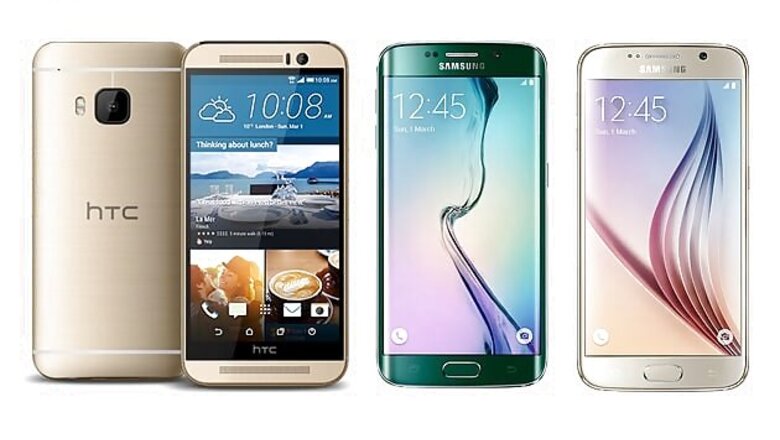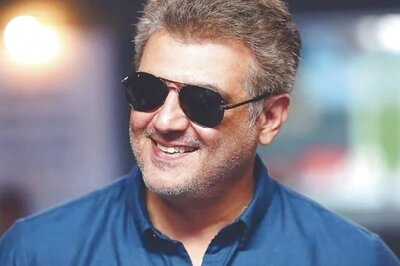
views
New Delhi: Following a string of leaks and rumours around its next flagship phones, both Samsung and HTC on Sunday launched their new high-end smartphones in the Galaxy S and One series, respectively. While the South Korean giant introduced two variants of the latest Galaxy S6 phone - one with a flat display and the other with a dual-curved screen (Galaxy S6 Edge) that curves around the left and right edges, HTC introduced the One M9, the third in the One series, with a look and feel very similar to the last year's model - the M8.
How do these new flagship phones measure against each other? We find out.
1. Appearance: From the outside, the new HTC One M9 smartphone looks and feels like last year's model. The One M9 borrows many of the elements, including a metal design and polished finish, from the M8. In terms of look, the only highlight in the One M9 is the dual-tone finish.
Samsung, for the Galaxy S6 phones, has ditched its much-criticised signature plastic design for more stylish metal and glass. Samsung's S6 phones have a metal frame - like the iPhone. The phones also have a glass back, which Apple abandoned in favour of metal in recent iPhones.
The casings used in Galaxy S6 phones are made from light-weight metal used in airplanes, a step up from the plastic that disappointed many critics of the S5. The phones come with Gorning's Gorilla Glass protection on both front and back.
This change is welcome, however it appears to be a little too late.
2. Camera: For years, HTC has kept its phone's main camera at 4 megapixels and made sensors for each of those pixels larger to capture more light. That's great for low-light situations, but it results in dull shots otherwise. The camera's low resolution is particularly noticeable when cropping photos. Customers "love the great low-light performance, but wanted more pixels for editing," said HTC executive Luis Sanchez.
The new phone, therefore, will have a 20-megapixel rear camera, at par with other leading Android phones. The lens will be made of sapphire to protect from scratches. The 4-megapixel UltraPixel rear camera from previous models has moved to the front in the HTC One M9, where low-light capabilities are more important because the front doesn't have a flash.
Although the resolution of the Galaxy S6 phones' rear camera remains at 16 megapixels, cameras on both sides will have wider openings to let in more light and make for sharper photos. The phones also promise better focus and colour accuracy - achieved in part by using the infrared capabilities on the phones' heart-rate sensor to detect lighting conditions.
3. Display: Like last year's model, the screen on HTC One M9 measures 5 inches diagonally (441 ppi). The 5-inch screen size and the 1080p resolution remain the same as on the HTC One M8.
The screen on the S6 also remains the same ie, 5.1 inches, but the display resolution increases to 577 pixels per inch, up from 432 in last year's Galaxy S5. By comparison, Apple's 4.7-inch iPhone 6 has 326.
Comparing the two, the HTC One M9 has a full HD display with a resolution of 1920x1080 pixels, while the S6 phones house a Quad HD (2560x1440) display.
4. Software and bloatware: Both the phones from HTC and Samsung are based on Android 5.0 Lollipop with their own layers atop.
The new HTC One M9 brings notifications to the lock screen and offer home screens customised to your location. At home, for instance, you might get easy access to Netflix and Facebook. At the train station, you might get suggestions for transit apps.
Samsung stripped out many of its unpopular in-house apps that infuriated users by gobbling up memory. The fingerprint sensor in the S6 phones is also improved. Instead of swiping down on the home button, you simply touch it, much the way you already do on iPhones.
5. Processor: At the heart of the new HTC One M9 is Qualcomm's latest Snapdragon 810 processor with 64-bit computing on 8 CPU cores. It's the same processor that powers the LG G Flex 2.
The new Galaxy phones will be powered by Samsung's own 64-bit, 14-nanometer Exynos processors, a departure from its previous reliance on Qualcomm's chips.
6. Battery and wireless charging: Previous Samsung phones had removable plastic backs, so the battery could be swapped with a spare, but batteries in the new S6 phones cannot be replaced. To compensate, the devices are the first from Samsung to support wireless charging without a dedicated accessory and can also get four hours of power with a 10-minute charge by cord.
The HTC One M9, on the other hand, does not support wireless charging. It includes a 2840mAh battery.
7. Storage: The HTC One M9 includes 32GB storage on board, which can be expanded further up to 128GB using a microSD card. The Galaxy S6 will come with 32GB, 64GB and 128GB storage options, with no option to expand its memory. This makes the S6 and S6 Edge, the first phones in Samsung Galaxy S series to not have support for expandable storage.
8. Mobile payments: Samsung is also touting the Galaxy S6's compatibility with a new mobile payments system it is preparing to launch in the United States and South Korea in the second half of this year. The system, in partnership with major US banks and credit card companies including Visa and MasterCard, will allow users to make mobile payments through magnetic strip-card readers without an external accessory needed for other models.
HTC hasn't equipped the One M9 with similar mobile payment abilities.
9. Colours: The HTC One M9 will be available in four colours - silver, gunmetal grey, pink and gold.
The Galaxy S6 will be available in White Pearl, Black Sapphire, Gold Platinum, Blue Topaz (Galaxy S6 only) and Green Emerald (Galaxy S6 Edge only).
10. Availability: The HTC One M9 is expected to come out in March in some markets. A US debut is likely in April.
The Galaxy S6 and Galaxy S6 Edge will be available in 20 countries (including India) starting from April 10.
Prices weren't immediately announced.
####HTC One M9 versus Samsung Galaxy S6 versus Samsung Galaxy S6 Edge

















Comments
0 comment